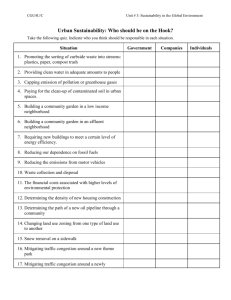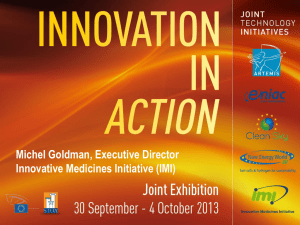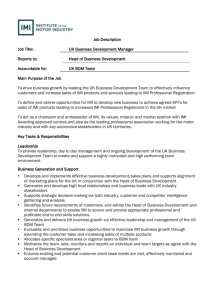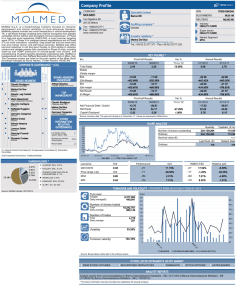Illinois Manufactuer, Inc. (IMI)
advertisement
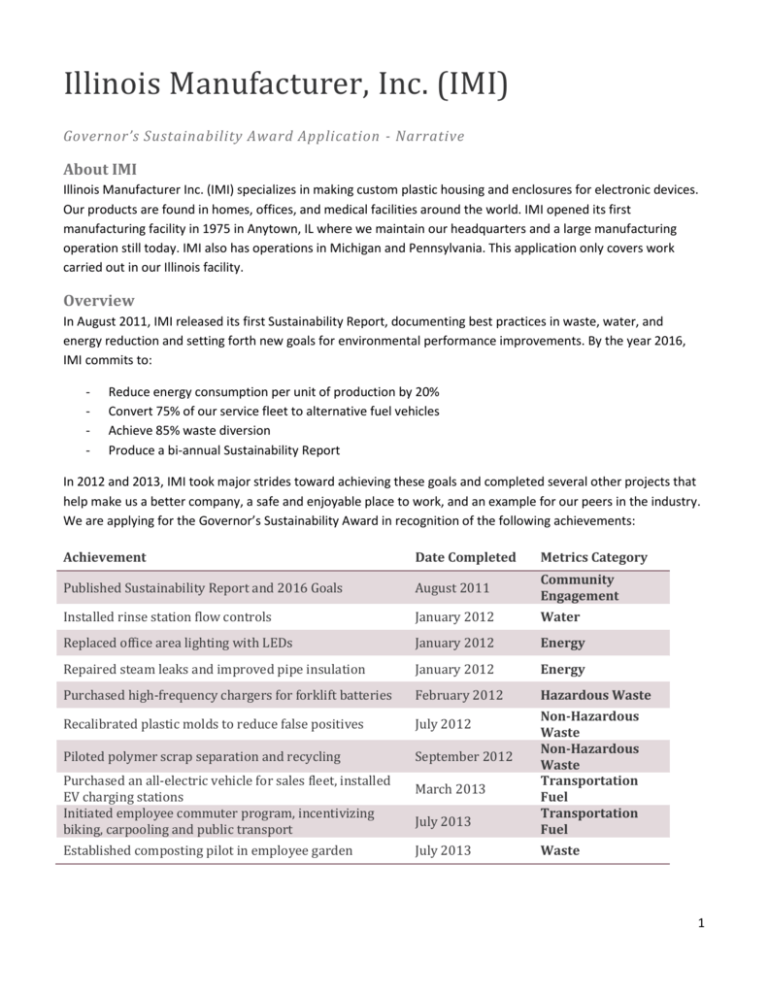
Illinois Manufacturer, Inc. (IMI) Governor’s Sustainability Award Application - Narrative About IMI Illinois Manufacturer Inc. (IMI) specializes in making custom plastic housing and enclosures for electronic devices. Our products are found in homes, offices, and medical facilities around the world. IMI opened its first manufacturing facility in 1975 in Anytown, IL where we maintain our headquarters and a large manufacturing operation still today. IMI also has operations in Michigan and Pennsylvania. This application only covers work carried out in our Illinois facility. Overview In August 2011, IMI released its first Sustainability Report, documenting best practices in waste, water, and energy reduction and setting forth new goals for environmental performance improvements. By the year 2016, IMI commits to: - Reduce energy consumption per unit of production by 20% Convert 75% of our service fleet to alternative fuel vehicles Achieve 85% waste diversion Produce a bi-annual Sustainability Report In 2012 and 2013, IMI took major strides toward achieving these goals and completed several other projects that help make us a better company, a safe and enjoyable place to work, and an example for our peers in the industry. We are applying for the Governor’s Sustainability Award in recognition of the following achievements: Achievement Date Completed Metrics Category Published Sustainability Report and 2016 Goals August 2011 Community Engagement Installed rinse station flow controls January 2012 Water Replaced office area lighting with LEDs January 2012 Energy Repaired steam leaks and improved pipe insulation January 2012 Energy Purchased high-frequency chargers for forklift batteries February 2012 Hazardous Waste Recalibrated plastic molds to reduce false positives July 2012 Piloted polymer scrap separation and recycling September 2012 Purchased an all-electric vehicle for sales fleet, installed EV charging stations Initiated employee commuter program, incentivizing biking, carpooling and public transport Established composting pilot in employee garden March 2013 July 2013 July 2013 Non-Hazardous Waste Non-Hazardous Waste Transportation Fuel Transportation Fuel Waste 1 Published Sustainability Report and 2016 Goals August 2011 | Community Engagement IMI has a certified Environmental Management System (ISO 14001:2004) in place, which acts as a sustainability policy for the entire company, ensuring that we are continually tracking our environmental impacts and seeking areas of improvement. The IMI Sustainability Team – consisting of employee representatives from each area of the company – is responsible for implementation of data tracking, project implementation, and employee awareness/engagement efforts. Starting in 2010, the Sustainability Team engaged IMI’s top management, engineers, and floor supervisors in completing a Sustainability Report. The Report consists of data and information on current environmental, social, and economic performance – collected and reported in adherence with Global Reporting Initiative (GRI) standards (for more information on GRI standards, see: www.globalreporting.org). The Sustainability Team also wanted to include a series of 5-year improvement goals in the Report. These were formulated through a series of Sustainability Team meetings, with input from IMI employees at all levels including top management, engineers, office staff and manufacturing staff. The Sustainability Report was released publicly in August 2011 and can be viewed here: www.globalreporting.org/Pages/imi-2011.aspx This was a landmark event for the company and has helped us focus on initiatives that have a strong positive impact on both environmental health and the longevity of our company. Installed rinse station flow controls January 2012 | Water One of IMI’s production lines has a rinse station that previously received water at a constant flow rate, calibrated to the maximum production rate on the line. Our manufacturing engineers developed and installed a flow rate controller that matches water volume input to the production rate. This simple control had a significant impact on our water consumption. We estimate that it reduced water consumption by 25% for an average production day, equaling 105,000 gallons of water and approximately $500 saved annually. Replaced office area lighting with LEDs January 2012 | Energy As part of our energy reduction initiative, the Sustainability Team sought advice from the local electric utility on potential energy efficiency savings and associated financial incentives. While LED replacements represent a significant energy-saving opportunity throughout our facility, we decided to start with replacing the T12 fluorescent lighting in our office areas with LED tubes. With support from the utility incentive, we were able to replace 100 T12 fixtures with LED equivalents that use 80% less electricity. Our annual savings from this project are estimated at 49,000 kWh and $5,600. 2 Repaired steam leaks and improved pipe insulation January 2012 | Energy The IMI facilities team conducted a careful review of the steam piping on the manufacturing floor and found several leaks that developed in areas of the plant without much foot traffic. They also identified areas with weak or ineffective insulation. By making these simple repairs, IMI saw an immediate savings in natural gas usage. We estimate the savings to be about 20,000 therms annually, representing around $8,000 in savings. Purchased high-frequency chargers for forklift batteries February 2012 | Hazardous Waste Our facility has four battery-operated forklifts – two in shipping/receiving and two in production - that are operated frequently throughout the day. While battery operation is beneficial for air quality, we are required to store up to three extra batteries for each forklift and dispose of the batteries properly at the end of their life. We purchased a set of high-frequency battery chargers that significantly reduce the charging time for each of the forklift batteries. We have been able to cut the amount of spare batteries we keep on hand by half. Additionally, each of the battery chargers is equipped with a microprocessor controller that uses charging algorithms to prevent under- and over-charging, extending the life of the batteries. Fewer extra batteries and extended battery life equate to less battery purchases and about 1,000 pounds less hazardous waste disposed on an annual basis. We estimate the cost savings of this measure to be around $2,000 annually. Recalibrated plastic molds to reduce false positives July 2012 | Nonhazardous Waste In pursuit of IMI’s waste reduction goal, our manufacturing engineers were tasked with reviewing opportunities for waste avoidance on the manufacturing floor. Their research yielded two different efforts at reducing waste plastics from our molds. The first effort re-calibrated the vision systems on five molds, which were was causing acceptable final products to be rejected – these are called “false positives.” We estimate that this recalibration reduced false positives by 75%, reducing plastic waste by an estimated 11,000 pounds (~5.5 tons) annually. The estimated raw material cost savings are $6,950 per year. Piloted polymer scrap separation and recycling September 2012 | Nonhazardous Waste The manufacturing engineer team also began piloting a project to increase the recyclability of our plastic scrap. Currently, the plastic flakes from our mill machines are fed out into tubs which are then emptied together into a 15 cubic-yard trash compactor. The compactor is picked up and taken to a landfill once per week. This material is not recyclable because such a great variety of plastic polymers are mixed together in the compactor. The engineering team identified the most voluminous polymer used in our manufacturing process and created a separate collection system for the mills that run that material. Now that this scrap is acceptable for recycling, we no longer need to have the trash compactor picked up each week. Instead we have worked with the garbage company to have the compactor picked up on an on-call basis. We estimate the annual impact of this system change to be 58,000 pounds of material diverted from landfill, and $17,000 in disposal costs avoided. 3 Added electric vehicles to fleet and installed EV charging stations March 2013 | Transportation Fuel Our service, repair, and sales staff use a mix of sedans, pickup trucks, and vans for their work. In total, the IMI company fleet consists of 20 vehicles. When we set our goal of converting 75% of our fleet to alternative fuel vehicles, we already had two flex-fuel trucks that run on E85 ethanol as well as a salesman car that runs on compressed natural gas (CNG). In 2013 we purchased two all-electric vehicles. With an EPA range of 75 miles, both vehicles will be able to make routine customer visits without consuming a single gallon of gasoline. Ultimately, we decided to install a total of four charging stations in our parking area – two for the company vehicles and two for employees. This opens up the opportunity for employees to feel comfortable about using an electric vehicle for their commute to work. With two electric sales vehicles on the road, and two commuters switching to electric, our estimated fuel and emissions savings are estimated at 1,700 gallons of gasoline and 15 metric tons of CO2. Initiated employee commuter program March 2013 | Transportation Fuel To further reduce the fuel and carbon intensity of our employee’s commutes, the Sustainability Team worked with IMI’s Human Resources department to develop a clean commute incentive program. The incentive program provides the following incentives for employees who use means other than a personal vehicle to get to work: Carpooling: IMI set up an intranet site for employees to share their routes to work and find overlapping commutes. The website allows employees to post their carpooling activity. Employees receive a gift certificate for every 40 carpool trips they log. Active Transport (biking/walking): Walkers and bikers are also encouraged to post their commutes on our intranet site. Bikers who live more than 10 miles from work receive a gift certificate for every 40 trips they log. Additionally, bikers and walkers who log at least 1 trip per week are provided with a storage locker for a change of clothes and shower supplies at the office. Public Transport: The nearest train station to our office is 2 miles away and the nearest bus stop is 1 mile away. Our first commuter survey of employees showed that 15% of employees would be incentivized to take public transportation if there was a shuttle to take them from the bus/train station to the office and back every day. IMI is currently piloting 8am, 9am, 5pm and 6pm shuttles for this purpose. There are 15 employees taking advantage of this service. 4 Established composting pilot in employee garden August 2013 | Nonhazardous Waste Our Sustainability Team has maintained a small employee garden on our grounds since 2006. This year, the Sustainability Team worked on establishing a system for collecting coffee grounds, tea bags, and raw fruit and vegetable scraps from employee break areas. These scraps are collected separate from the trash and transported to the employee garden where they are composted along with garden scraps and yard trimmings. Establishing this program required three major efforts: 1) Train employees – The Sustainability Team created signage indicating, with actual photographs, which items are acceptable in the compost program. The team also purchased countertop compost collection pails with lids. Two pails, with accompanying signage, were added to each of the three employee break rooms throughout the IMI facility. Finally, the Sustainability Team hosted a catered “Lunch and Learn” event for all employees to explain the program, answer questions, and demonstrate which types of leftovers are compostable. 2) Coordinate with janitorial staff – IMI worked with the janitorial company that services our facilities to ensure that the breakroom compost pails are emptied on a nightly basis. The pails are emptied into a green rolling container housed outside near the garden. The Sustainability Team and gardening group are then responsible for emptying the rolling container into the compost area on a weekly basis. 3) Improve composting area – The Sustainablity Team used a portion of their budget to purchase materials for constructing a three-bin garden composting system. The team was able to keep costs low by repurposing used wood pallets as the siding for the three compost collection areas. This system keeps the compost contained and controls the progression of the composting process. The compost yields, on average, 30 gallons of compostable material per week. This equates to about 2,300 pounds of landfill diversion per year. Ongoing Activities IMI will continue in pursuit of the sustainability goals we have set to achieve by 2016. Here’s a breakdown of the process that we need to make in the next two years to achieve them: Goal Current Status Reduce energy consumption per unit of production by 20% Currently at 16.5% reduction - Considering geothermal heating/cooling system. Convert 75% of our service fleet to alternative fuel vehicles Currently at 20% - Planning four hybrid truck purchases in 2014. - Expand polymer separation pilot - Establish commercial compost program that will accept wider range of items. - Establish 1-2 sustainability job positions that will keep reporting and progress on track. Achieve 85% waste diversion Currently at 50% waste diversion Produce a bi-annual Sustainability Report Behind-schedule for second sustainability report. Planned release August 2014 Upcoming Projects Regulatory Compliance Illinois Manufacturer Inc. is not subject to any environmental enforcement action or notice of violation from the U.S. EPA or Illinois EPA. 5 Illinois Manufacturer Inc. (IMI) Governor’s Sustainability Award Information – Supplemental Documentation Normalized Impact Data To help us get an accurate perspective on the impact of our efforts, we took a look at our 2012 vs. 2013 energy usage, waste generation, and fuel usage and normalized the numbers. The comparison data is summarized below. Note that this information will conflict in some cases with the information reported above, because project s were initiated and finished at different times of the year. Metrics Category Normalization Metric FY2012 Usage FY 2012 Normalizing Quantity 6,500 FY2012 normalized FY2013 Usage Energy Electricity # units shipped 1,800,000 kWh Energy Natural Gas # units shipped Waste Landfilled Waste Water FY2013 Normalized % Reduction 1,725,000 FY2013 Normalizing Quantity 6,750 277 kWh/unit 256 kWh/unit 7.5 % 350,000 therms 6,500 53 therms/unit 330,000 6,750 49 therms/unit 9.3 % # units shipped 190,000 lb 6,500 29 lb/unit 120,000 6,750 18 lb/unit 39 % # units shipped 420,000 gallons 6,500 65 gal/unit 330,000 gallons 6,750 49 gal/unit 25 % Photos EV Charging in IMI parking lot Used-pallet compost collection bays in employee garden Close-up of LED T8 replacements Source-separated plastic flakes – diverted from landfill 6



